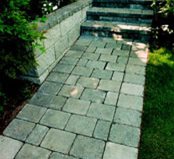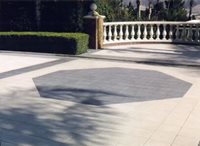- Concrete Paver Information
- Concrete Paver Pictures
- Patio Pavers
- Driveway Pavers
- Pool Deck Pavers
- Sidewalk & Walkway Pavers
- Porous and Permeable Concrete Pavers
- Installing Concrete Pavers
- Pavers Installation: Step-by-step overview of base compaction and mechanical installation
- Pricing of Concrete Pavers
- Paver Thickness & Specifications
- Other Resources
- Find Products: Pavers & Supplies
Concrete Pavers
Learn about concrete paver styles, construction and installation for creating patterned surfacesIf you're considering concrete pavers for your home, use the following information to determine if they are the best option.
What Are Pavers?
Concrete pavers, often referred to as paving stones, are a popular outdoor flooring option. Similar to tiles, pavers are manufactured in specific shapes, sizes and colors and arrive on site ready to be installed.
Check out our photo gallery to see what they look like: Concrete Paver Pictures
Pavers are most commonly installed over a compacted base of soil and sand. Because there isn’t any grout between the joints, concrete pavers offer a permeable surface that allows water to pass through. However, this also means that they may shift over time and that weeds could grow between the stones. Hiring a professional paver contractor to install your pavers, rather than laying them yourself, is the best way to protect your patio, driveway or sidewalk from these concerns.
 Patio Pavers
Discover the benefits of using pavers for a patio and get maintenance and installation tips.
Patio Pavers
Discover the benefits of using pavers for a patio and get maintenance and installation tips.
 Driveway Pavers
Learn about the reasons for using pavers for a driveway and get maintenance and installation advice.
Driveway Pavers
Learn about the reasons for using pavers for a driveway and get maintenance and installation advice.
 Pool Deck Pavers
Find out why people choose pavers for around their pool and get tips for installing and maintaining a paver pool deck.
Pool Deck Pavers
Find out why people choose pavers for around their pool and get tips for installing and maintaining a paver pool deck.
 Walkway Pavers
Discover the benefits of using concrete pavers for a walkway & get installation & maintenance tips.
Walkway Pavers
Discover the benefits of using concrete pavers for a walkway & get installation & maintenance tips.
 Paver Cost
How much do pavers cost? Get average installation costs by the square foot.
Paver Cost
How much do pavers cost? Get average installation costs by the square foot.
 Paver Installation
Get a step-by-step overview of the paver installation process and learn special considerations for base compaction.
Paver Installation
Get a step-by-step overview of the paver installation process and learn special considerations for base compaction.
The use of concrete pavers is growing rapidly on both commercial and residential construction projects. Interlocking pavers form a patterned surface which can be put into service immediately. Pavers are manufactured in various textures and colors. A big benefit of pavers is that they can be removed and re-installed, which reduces future service interruptions.
There is plenty of growth to go: in Europe there are 100 square feet of pavers installed per person annually whereas, in the United States it is only 1 square foot per person. Pavers can be installed on your driveway, on a walkway, and on a patio. Pavers come in a variety of patterns, colors and styles to suit most any design idea.
Concrete Paver Styles
Concrete pavers come in a literally endless number of styles. Pavers are often manufactured and supplied on a regional basis and thus the same paver may not be available throughout the country.
The same project can use two or more different colors of concrete pavers. Textures can also be mixed.
Here are two samples of available styles:

Tile Tech Pavers
Roman is tumbled to soften the edges and give the classic look of hand hewn stone. The earth tone colors harmonize with any decor, blending naturally into the landscape, aging gracefully to provide paving with a timeless elegance.

Tile Tech Pavers
The classic look of an octagon combined with a square. Good interlocking characteristics make Cobble one of the most versatile paver shapes. The subtle earth tones and color blends make this paver one of the first choices of paving projects.
Concrete Paver Designs
Designers choose paver styles to harmonize with the surrounding area. Two colors of pavers can be combined to provide interest in large areas. Pavers also come in blended colors to add interest.
Pavers are similar to other colored concrete, or brick products: shade variations may occur. This can result from slight variations in dye lots and the raw materials used. Install pavers from several pallets at a time.
Here are some additional design considerations:
- Pavers can be selected to complement the stone or facade on the building. Oftentimes, pavers one or two shades lighter than the structure are selected so as not to compete for attention with the structure.
- The use of brick pavers with wood or stone houses adds warmth.
- Pavers can have different textures. When different textures are combined it adds interest.
- Avoid long straight rows of pavers. If straight runs are required, lay the edge pavers parallel to the edge of the path and use a basket weave pattern in the interior.
- For Victorian style houses, repeat the curves of the arched windows and doors by designing curved edges.
- For rectangular colonial styles, repeat the shape by using brick-shaped pavers.
- For brick homes, select pavers lighter than the brick used on the home or use cobblestone.
Find a Concrete Pavers Contractor
Concrete Pavers Maintenance & Repair
When installed properly over a well-compacted subbase (see Installing Concrete Pavers), precast concrete pavers will rarely crack, shift or settle under normal foot or vehicle traffic. The compacted bed of aggregate beneath the pavers will help prevent settlement, and the joints, or gaps, between the pavers will allow for expansion so the pavers will not crack due to freezing and thawing.
Pavers can settle in spots over time if they aren’t installed properly over a stable subbase. However, they can easily be reset by removing the affected pavers and regrading and recompacting the subbase. Pavers can also be removed and reinstalled in this manner if utility repairs are required.
Typically, routine maintenance of paver surfaces involves removing dirt and leaves by sweeping and occasional rinsing. For heavy oil or grease stains, use a pressure washer with an appropriate cleaning solution. Depending on weather exposure, you may need to replenish the sand in the paver joints every 2 or 3 years if it washes away due to erosion. If polymer sand is used at the time of paver installation, joint sand addition may not necessary. This special type of sand contains a polymeric additive that binds and hardens the sand and helps to prevent erosion. Sealing concrete paver surfaces will also help to lock in the sand while protecting the pavers from staining. However, sealing does require periodic reapplication depending on the product used and traffic exposure.
Low gloss paver sealer on Amazon.
In the winter, paver driveways can be plowed or shoveled without dislodgement because they typically have chamfered edges and joints. However, don’t use sharp objects to chop ice, which can damage the pavers. Instead, add traction with sand or apply a noncorrosive deicer, such as calcium magnesium acetate. Learn more: Driveway Pavers.
How to Hire a Concrete Paver Contractor
Just knowing something about a contractor isn't enough. In order to ensure a quality installation, you should ask questions of the contractor like:
- How long have they been installing pavers?
- Have they been trained by a manufacturer or by the ICPI? Do they have written certificate of completion?
- What percentage of their total business consists of installing concrete pavers?
- Will they provide you with three references, not only recent ones, but from past jobs?
- Can you contact their references and inspect the jobs?
- Do they have a portfolio of photos and letters to qualify themselves?
- Are they in good credit standing?
- Do they have a current liability insurance certificate? While the contractor is on your property, they should be insured for any damage and injuries that may occur. Check your homeowners insurance policy for coverage of the contractor while on your property.
- Can the contractor provide proof that Worker Compensation Insurance covers all of the job?
- Do they install the job per ICPI specifications? Can they supply a copy?
- Do they provide a written, itemized proposal outlining the scope of work and terms of payment? It should include starting and completion dates, demolition and excavation paving and base materials, and taxes.
- Do they guarantee their work for one year? Will they return in a year to inspect it?
- Are they members of the ICPI or other associations?
With answers to these questions and others you might have, plus answers on how to know when the installation is being done right, you should be able to select a competent contractor. The above information is courtesy of the Interlocking Concrete Paver Institute.
 Concrete Patios
Learn how concrete gives you complete creative freedom to bring the style and elements of your indoor rooms to the outdoors.
Concrete Patios
Learn how concrete gives you complete creative freedom to bring the style and elements of your indoor rooms to the outdoors.
 Concrete Driveways
Discover design options for a durable, low-maintenance decorative concrete driveway that boosts the curb appeal of your home.
Concrete Driveways
Discover design options for a durable, low-maintenance decorative concrete driveway that boosts the curb appeal of your home.






